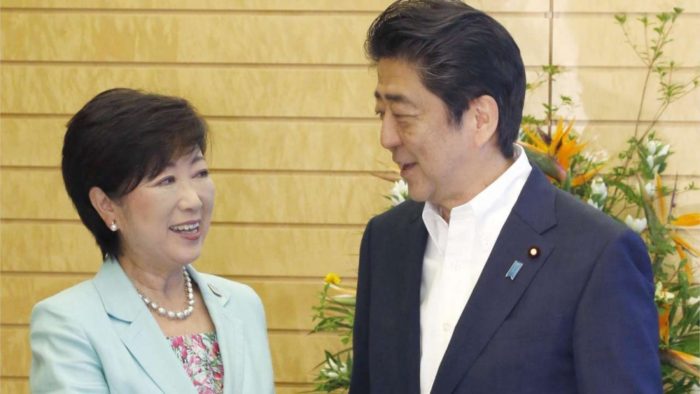Published in the Nikkei Asian Review 27/9/2017
Is Japanese Prime Minister Shinzo Abe about to do a Theresa May? In June, the British prime minister called an unnecessary general election because the opinion polls gave her a supposedly unassailable lead. In the course of the campaign, that lead dwindled to almost nothing due to a combination of inept campaign strategy and astute politicking by her opponent, the wildly underestimated Jeremy Corbyn. It is now touch-and-go whether she survives until the end of the year.
Like Corbyn, Tokyo Governor Yuriko Koike is a seasoned operator with a flair for populist gestures and a justly earned reputation for standing apart from the crowd of colorless party hacks. Unusually for a Japanese politician, she has no coalition of vested interests behind her, no party machine and no network of influential backers. Her approval ratings of 60-70% are well above those achieved by Abe even at his peak popularity
There is one further eerie resemblance. Theresa May’s campaign ran into trouble because of a series of ham-fisted proposals to tighten fiscal policy in line with the “austerity” strategy dictated by the U.K. Treasury and channeled by her chancellor of the exchequer. Abe has got himself into a similar pickle by agreeing to a deeply unpopular hike in the consumption tax, as demanded by the Ministry of Finance and his own Finance Minister, Taro Aso.
On all three of the previous occasions that the consumption tax was hiked, recessions followed. Abe knows this well enough because the last time was in 2014 and the result was a sharp fall in his own popularity. This time, in an attempt to mitigate the regressive effects, he is promising to use half the revenue raised to fund free education and other giveaways. Even so, any fiscal tightening at all represents a dilution of the Abenomics reflationary drive and looks like a capitulation to the unreconstructed fiscal hawks in the bureaucracy.
In contrast, Koike’s message is strong and clear — no consumption tax hike until the economy can bear it. Likewise, her “zero nuclear power” stance is likely to garner support from younger people and celebrities as well as potentially winning the backing of another maverick, former Prime Minister Junichiro Koizumi who has reinvented himself as an anti-nuclear campaigner.
With a large proportion of unaffiliated voters — around 30%, according to some polls — it would not be a huge surprise if Koike’s brand new “Party of Hope” scored significant successes, particularly in Tokyo and surrounding areas. It might end up as Japan’s third, perhaps even second largest party.
Yuriko is no Jeremy
It will be after the election that things may get interesting. Although Koike is portrayed in the media as a direct challenger to Abe, the similarities between them are much greater than the differences. If the center-left Democratic Party, currently the largest opposition party, bears the brunt of the Party of Hope’s advances, Abe may find that his room for manoeuvre has increased.
Koike has rattled the cages of vested interests and favors better conditions for working women, but politically she is as far from Corbyn-style leftism as you can get. A member of the Nippon Kaigi association of conservative activists and a regular worshipper at the controversial Yasukuni Shrine, she is to the right of Abe on many issues.
For example, like many Japanese conservatives, she feels that Abe’s minimalist proposal for constitutional reform — which merely spells out that Japan’s Self-Defense Forces are legal — does not go nearly far enough. Instead, she favors a wholesale rewriting. Her views on North Korea are similarly robust. It was because of these ideological credentials that Abe made her Japan’s first-ever female minister of defense during his short-lived administration of 2007.
It is possible that a resounding electoral success could encourage Koike to plot a return to the national parliament, but that would mean giving up her current job. The governorship of Tokyo involves managing an urban agglomeration larger than many European countries in economic scale. With the 2020 Olympics around the corner, it offers more power, responsibility and exposure than all but the top three or four cabinet posts. It would make more sense to complete her term, which ends in August 2020, and then to weigh her chances in the post-Abe world.
And Shinzo is no Theresa
The obvious strategy for both players is to form an official or unofficial alliance. Currently the ruling Liberal Democratic Party’s partner in coalition is Komeito, a party affiliated to the Buddhist Soka Gakkai organization. Soka Gakkai has a strongly pacifist orientation — one of its founders was a dissident who died in prison during the war. Every initiative that Abe has promoted on security and defense issues, including his constitutional reform proposal, has had to take this into account.
The relationship between the LDP and Komeito is a political marriage of convenience. A relationship between Abe’s LDP and Koike’s Party of Hope would be built on mutual attraction. It is notable that Abe has refrained from any personal criticism of Koike; in fact, he has gone out of his way to build her up as “a formidable opponent,” and has complimented her choice of party name.
Abe has an unbroken record of election successes. He has highly experienced and sophisticated political advisors who will have examined all possibilities and permutations. What about an outcome that further marginalises the left in parliament, offers an alternative choice of coalition partner and leads to the scrapping of the tax hike and more wide-ranging constitutional reform? Technically it would be a defeat, but in terms of furthering the Abe agenda it would look like a victory.

